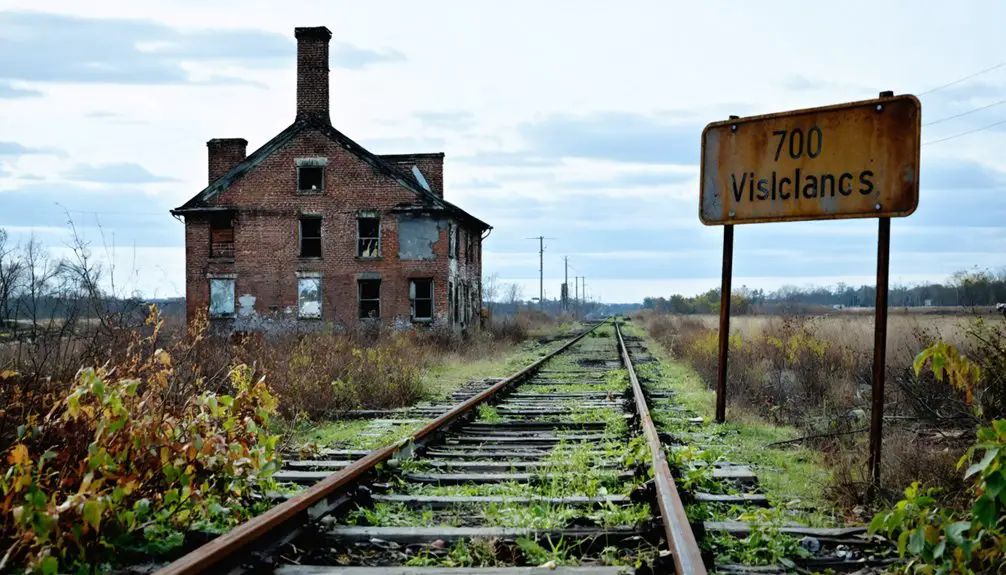You’ll discover that Toonerville, Missouri, a vibrant riverside community named after a popular comic strip, met an abrupt end in late 1940. The U.S. government seized 17,000 acres through eminent domain, giving residents just three months to vacate their homes and businesses. What began as a quirky homage to a newspaper comic transformed into one of Missouri’s most poignant ghost towns, where scattered foundations and stubborn chimneys tell a deeper story of wartime sacrifice.
Key Takeaways
- Toonerville was a vibrant Missouri community named after a popular comic strip, featuring a close-knit settlement near the Missouri River.
- The U.S. government seized Toonerville through eminent domain in 1940, forcing approximately 500 farming families to evacuate within three months.
- The town was completely demolished to make way for weapons development, with all buildings, churches, and schools systematically removed.
- Only scattered foundations and chimneys remain of the original town, which was part of a larger 17,000-acre military acquisition.
- Environmental contamination from dioxins has left the area restricted, with cleanup efforts costing millions of dollars.
From Comic Strip to Community Name
When Fontaine Fox launched his comic strip “Toonerville Folks” in the Chicago Post in 1908, he couldn’t have known that his creation would inspire the naming of a real community in Missouri.
The comic’s influence spread rapidly after Wheeler Syndicate began national distribution in 1913, capturing America’s imagination with its quirky portrayal of small-town life. The strip delighted readers with its rickety trolley line and colorful cast of suburban characters. To help readers find related content, Wikipedia created disambiguation pages for various Toonerville locations.
You’ll find the strip’s cultural significance reflected in how Toonerville, Missouri, got its name. A local gas station owner, recognizing the comic’s popularity, incorporated its imagery into his roadside signage.
The name stuck, and soon the entire unincorporated community in St. Charles County became known as Toonerville.
It’s a rare example of popular media directly shaping local identity in early 20th century America.
Life Before World War II
Before its abrupt transformation into a military facility, Toonerville flourished as a small but vibrant community in southern St. Charles County.
You’d find this rural hub nestled near the Missouri River, where it grew from a simple roadside gas station into a close-knit settlement. Despite its isolation from St. Louis, the town’s proximity to Hamburg’s railroad connections helped sustain local commerce and community life. Boy Scout troops maintained a thriving camp in the area, with structures supported by living trees.
A modest riverside community transformed from a lone gas station into a thriving town, connected to the world through Hamburg’s vital railways.
You can imagine the rural nostalgia of daily life, with residents gathering at local churches and schools, while nearby rail stops at Hamburg and Howell linked them to broader markets. The town was one of several that fell victim to the Weldon Spring project, which reshaped the entire region.
The community’s resilience showed in how they maintained their small-town character until October 1940, when the government’s sudden acquisition gave residents just three months to abandon their homes, forever changing this peaceful rural settlement.
The Government’s Land Acquisition
You’ll find that the U.S. government’s acquisition of Toonerville and surrounding lands happened swiftly through eminent domain powers, with the R. Newton McDowell Company serving as the government’s agent to negotiate purchases in late 1940.
Within three months, residents were forced to vacate their properties as crews began systematically demolishing or burning most structures, including homes, businesses, and community buildings. Similar to Times Beach residents who faced inadequate buyout prices based on square footage, many Toonerville families struggled with the compensation offered.
Your community’s buildings closest to the planned TNT plant were spared from demolition but were repurposed for the war effort, marking a definitive end to civilian life in Toonerville. The site would go on to produce 700 million pounds of TNT by the end of World War II in 1945.
Eminent Domain Legal Process
The government’s acquisition of Toonerville through eminent domain followed Missouri’s strict legal framework, which required multiple steps and safeguards for property owners.
You’d have received a notice of acquisition at least 60 days before any court filing, explaining your rights and the project’s purpose. Within that period, state-licensed appraisers would’ve evaluated your property, leading to a formal written offer that had to remain open for 30 days.
If you’d rejected the offer, the court appointed three local commissioners to determine just compensation. While you could’ve challenged both the taking and valuation, the expanded definition of “public use” following the Kelo decision made it harder to dispute the government’s authority. Some residents may have qualified for a heritage value bonus if their properties had been in their families for over 50 years. The condemning authority needed to engage in good-faith negotiations before initiating any formal condemnation proceedings.
The process aimed to guarantee fair treatment, though many Toonerville residents likely found the experience challenging.
Rapid Three-Month Timeline
While Missouri’s eminent domain process typically allowed property owners significant time to respond, Toonerville’s fate unfolded at breakneck speed. In October 1940, the U.S. Army announced its intent to seize 17,000 acres for weapons development, giving residents just three months to vacate their homes and businesses.
You’ll find that military urgency drove this accelerated timeline, as the government anticipated America’s entry into World War II. The rapid relocation affected everyone – from homeowners and shopkeepers to churches and schools. The displaced community included 500 farming families who had cultivated these lands for generations.
Within this strict window, entire communities disappeared as demolition crews systematically removed all structures from Toonerville, Hamburg, and Howell. The Army’s swift action transformed a thriving rural community into a military installation, leaving no trace of the civilian life that once flourished there.
Property Demolition Protocol
Following formal declarations of eminent domain in 1940, government officials swiftly implemented an extensive demolition protocol across Toonerville and its neighboring communities.
You’ll find that demolition methods were ruthlessly efficient, as crews systematically destroyed homes, businesses, churches, and schools that had stood for generations.
- Officials ordered the immediate burning or razing of all civilian structures
- Crews worked under strict wartime deadlines to clear the entire 17,000-acre area
- Community displacement occurred with military precision, leaving families scrambling
- Demolition teams left only scattered foundations and chimneys as evidence
Today, you can still discover remnants of these destruction protocols scattered across the landscape – silent testimonials to a community that vanished under the government’s urgent wartime demands.
Forced Exodus and Demolition

You’ll find a somber chapter in Toonerville’s history when, in late 1940, residents received just three months to abandon their homes and businesses as the U.S. Army claimed 17,000 acres for wartime production.
Within this brief window, entire families packed their belongings and scattered to surrounding communities, leaving behind generations of memories and established roots.
Like its Arizona counterpart at Twin Arrows Trading Post, the town faced a complete transformation that erased its original character and purpose.
The Army’s demolition crews worked swiftly after the exodus, systematically destroying homes, churches, and schools until nothing remained of the once-vibrant railroad town.
Government Acquisition Timeline
As World War II loomed in 1940, the U.S. government swiftly acquired 17,232 acres in St. Charles County, Missouri, forever changing the lives of nearly 600 residents.
The acquisition rationale centered on the area’s strategic location near essential transportation routes and its relative isolation, making it ideal for a massive ordnance facility.
- By early 1941, you’d have witnessed government officials serving evacuation notices to families in Toonerville, Hamburg, and Howell.
- Despite limited community resistance, you would’ve seen residents forced to quickly abandon their homes and businesses.
- You’d have observed the systematic demolition of entire communities, with buildings burned or razed within months.
- You would’ve noticed the rapid transformation as construction crews built over 1,000 buildings for TNT production.
Resident Relocation Challenges
The forced exodus of Toonerville’s residents marked one of the most challenging phases of the government’s acquisition project.
You’ll find that residents faced devastating relocation difficulties when given just three months to abandon their homes and find new housing in late 1940. The U.S. Army’s rigid evacuation timeline left families scrambling to secure alternatives with minimal support or resources.
The emotional trauma ran deep as the community watched their houses, churches, and schools razed to the ground.
Without documented compensation or relocation assistance, residents bore the full burden of this displacement. They lost not just their physical homes, but their livelihoods, social bonds, and generational connections to the land – a harsh indication of the government’s prioritization of military needs over citizen welfare.
Community Structure Destruction
When federal authorities announced plans to acquire 17,000 acres in St. Charles County, they gave Toonerville residents just three months to abandon their homes and community.
This forced exodus marked a devastating blow to community resilience, as the government’s swift demolition erased generations of cultural heritage.
The destruction was methodical and complete:
- All residential buildings were immediately torn down following evacuation.
- Churches and schools, essential centers of community life, were demolished within weeks.
- Local landmarks that defined the town’s identity were systematically removed.
- The town’s unique name and character, inspired by a popular comic strip, vanished with its physical structures.
The extensive demolition eliminated any chance for residents to preserve their town’s legacy or maintain connections to their ancestral land.
Legacy of a Lost Township
Buried beneath decades of federal development and environmental cleanup lies the poignant story of Toonerville, a close-knit Missouri township whose fate changed overnight in 1940.
You’ll find Toonerville’s historical significance woven into the fabric of wartime America, where community resilience faced the ultimate test. When the government seized 17,000 acres for the Weldon Spring Ordnance Works, they weren’t just taking land – they were erasing a culture.
Today, all that’s left are scattered foundations, stubborn chimneys, and the occasional unverified whisper of a surviving structure.
Yet Toonerville’s spirit lives on through local archives and memoranda, its comic strip-inspired name a reminder of simpler times. The town’s story serves as a powerful indicator to how quickly the wheels of progress can transform thriving communities into mere historical footnotes.
Environmental Impact and Modern Status
Long after its residents departed, Toonerville’s environmental legacy stands as a sobering reminder of industrial contamination‘s devastating impact. The toxic legacy of dioxins and other hazardous chemicals forced widespread community displacement, turning this once-vibrant township into an uninhabited zone.
- You’ll find extensive federal cleanup efforts involved multiple agencies, including the EPA and CDC, with costs running into millions of dollars.
- The contamination spread through flooding events, affecting neighboring towns like Hamburg and Mechanicsville.
- You can see how agricultural lands became unsuitable for farming, while residential areas were deemed permanently uninhabitable.
- The area remains restricted today, serving as a cautionary tale of environmental negligence and the high price paid by local communities when industrial oversight fails.
Frequently Asked Questions
Did Any Former Toonerville Residents Receive Financial Compensation for Their Displacement?
You’ll find the displacement impact isn’t fully documented, but it’s likely residents received some compensation under eminent domain laws, though exact details of their compensation claims remain unclear in available records.
What Happened to the Original Gas Station Sign Featuring Toonerville Folks?
In 1941, when 17,000 acres were seized, you’d find no trace of the original sign. It’s likely destroyed with other structures during the military’s demolition, erasing this unique piece of Toonerville history.
Were There Any Known Cemeteries Within Toonerville’s Boundaries?
You won’t find official cemetery locations within the town’s borders, though local burial practices likely included small family plots that were later relocated during the wartime TNT plant development.
How Many People Lived in Toonerville at Its Peak Population?
You’ll find that exact peak population records remain elusive, but historical evidence suggests Toonerville’s peak growth reached the low hundreds before its population decline during the 1940-1941 military land acquisition.
Did Any Structures or Foundations From Toonerville Survive the Demolition?
You’ll find minimal architectural remnants today – only scattered foundations lie buried beneath vegetation. While two power station buildings survived, no original structures from historical preservation efforts remain standing.
References
- http://thetntstory.blogspot.com/2012/10/normal-0-microsoftinternetexplorer4_28.html
- https://kids.kiddle.co/List_of_ghost_towns_in_Missouri
- https://en.wikipedia.org/wiki/Toonerville
- https://en.wikipedia.org/wiki/List_of_ghost_towns_in_Missouri
- https://www.youtube.com/watch?v=a-AygB2G7kc
- https://en.wikipedia.org/wiki/Toonerville_Folks
- https://catchafallingstarbook.net/tag/toonerville/
- https://boards.straightdope.com/t/toonerville-trolley-question/832688
- https://catchafallingstarbook.net/2023/07/31/toonerville-a-place-i-once-lived-in-5/
- https://www.wikiwand.com/en/articles/List_of_ghost_towns_in_Missouri



